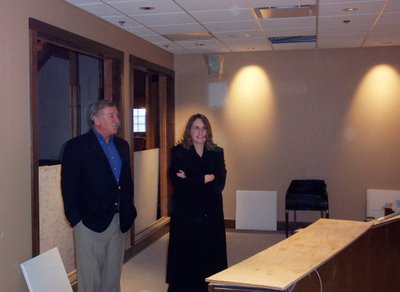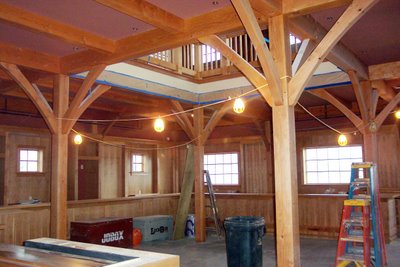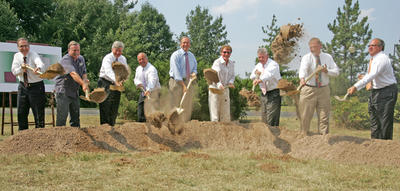... IN JUST SEVEN MONTHS,
CANANDAIGUA, NY -- The New York Wine & Culinary Center project has gone from groundbreaking ceremony in August 2005 to under roof and 10 weeks from a projected soft opening.
I toured the facility, on the shores of Canandaigua Lake near Rochester, NY, this weekend and -- confession time -- was amazed at the rapidity of construction.
Walking through construction-dust-coated corridors, offices and public spaces, the impressive upscale Adirondack-style design was unveiled -- from multi-hued, handworked wood wainscoting, stair railings, display shelving and counters to a 36-station kitchen, slate-floored rest rooms and views of the lake, the roughly $7 million project is coming together at a pace that some doubters, me included, have difficulty believing.
The center, noted director Alexa Gifford, will include entrance landscaping geared toward representations of indigenous plants from the region.
"We'll have local flowers and shrubs, grape vines and the like that will set the mood for visitors," she said. "Americans in general are used to pulling into a parking lot that leaves you right up to the door. We'll be guiding people along a path that creates a mood, and then they'll walk into this beautiful facility that will build on that atmosphere."
The center is being financed by $2 million in state funding and the rest from various private funds. The major private backers are Centerra, formerly known as Constellation Brands, the locally-headquartered company that is the world's largest manufacturer and distributor of alcoholic beverages; Wegman's Food Markets, a five-state chain based in Rochester, and Rochester Institute of Technology's Hospitality and Service Management School.
The mission of the Center will be to foster knowledge in the wine, agriculture and culinary arts industries across New York State. To do so, the Center will offer hands-on courses in culinary science; interactive exhibits on New York State agriculture, foods and wines; demonstration space; and a live garden outside of the building.
"We have been doing a lot of talking to various businesses and organizations that, understandably, are asking, 'What's in this for me? Aren't you competition?',' said Gifford. "We've been explaining that in no way will we compete with private businesses. We're here to enhance an understanding and support of New York's wonderful food and wine products. They like knowing that, and we're planning to work with schoolkids as well as tourists and businesses."
The 15,000 square-foot facility will include a tasting room with a rotating selection of wines from New York's major regions (Niagara/Lake Erie, Finger Lakes, Hudson Valley and Long Island), a wine and tapas bar for light meals and wine-and-food pairings, a theater-style demonstration kitchen, a training kitchen for hands-on cooking classes, and industrial kitchens for credited culinary classes and corporate training. It also will house the offices of the New York Wine and Grape Foundation.
Agriculture is one of New York's most vital industries, encompassing 25 percent of the state's landscape and generating more than $3.6 billion last year. It has 7.6 million acres of farmland with 36,000 farms and is the nation's third-largest wine-producing state after California and Oregon.
The project marks a major step in increasing the visibility of New York's wine industry to tourism and agribusiness interests. How significant the industry is to the state is shown in a just-released report from MKF Research, a California-based consulting firm analyzing New York's situation.
With 31,000 acres of vineyards, 212 wineries and 1,384 grape farms, New York is the nation's second largest wine producer after California and the third biggest grape grower behind California and Washington.
Wineries, grape producers and related businesses in New York, from liquor stores to makers of bottles, glasses and labels, account for almost 36,000 jobs and a $1.3 billion payroll, the state-funded study reported.
In addition, it said that wine sales alone generate $420 million in sales, but the state industry's multiplier impact on the economy came to $3.4 billion in 2004.
A FEW MORE VIEWS Photos by William M. Dowd
Photos by William M. Dowd
Alexa Gifford discusses the Center's progress with Jim Trezise, head of the New York Wine & Grape Foundation.



To Dowd's Spirits Notebook latest entry.
To Dowd's Wine Notebook latest entry.
To Dowd's Brews Notebook latest entry.
Back to Dowd's Bar Blog home page.


No comments:
Post a Comment